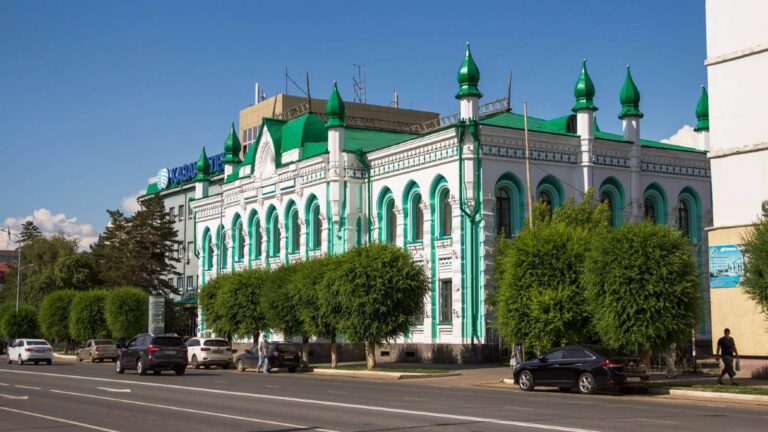Main image: Uralsk Review, CC BY 3.0, via Wikimedia Commons
Getting There
The museum is located in the central part of the city of Uralsk, at the address: Uralsk, Nursultan Nazarbayev Avenue, 35. The museum can be reached by public transport and taxi.
Phone: 8 (7112) 26 49 86.
What to Expect
The 18th century architecture monument – the house-museum of E. Pugachev has long been a place of pilgrimage for townspeople and city guests. In 1967, a library was located here, in 1991, the building was transferred to the regional history and local history museum. An extensive collection of household items and weapons of the Ural Cossacks is exhibited here: cannons, banners, valuable royal gifts.
The museum displays various weapons of the rebels and tsarist troops. Gloves were donated by Catherine II to the Yaik ataman Borodin for his active participation in the suppression of the Pugachev rebellion. You can see the portrait of Pugachev, painted over the portrait of Catherine, familiar to many from school history textbooks.
Also in the museum are copies of Pugachev’s “royal throne” and the cell in which he was kept during interrogations. furnishings and household items of the Yaik Cossacks are widely represented. The courtyard is no less interesting. There is a copy of the tarantass on which Pugachev came to woo his bride Ustinya Kuznetsova. You can also see various outbuildings with furnishings.
History
The Pugachev Uprising (the Peasant War of 1773-1775, the Pugachevshchyna, the Pugachev Rebellion, the Pugachev Uprising, the Emelyan Pugachev Uprising) was an uprising (rebellion) of the Yaik Cossacks, which grew into a full-scale war of the Cossacks, peasants and peoples of the Urals and the Volga region from the government of the Emperor and the Volga region from the government of the Urals and the Volga region.
In 1772, an uprising of the Cossacks broke out in the Yaitsky town against the elders’ elite of the army and representatives of the government. The uprising was suppressed, but the Cossacks did not resign themselves, but hid in anticipation of a pretext for a new uprising. Such an occasion presented itself with the appearance on the Yaik of the fugitive Don Cossack Pugachev, who declared himself Emperor Peter III.
A new uprising of the Yaik Cossacks, which began on September 17, 1773 from the Budarin outpost, quickly covered the entire Orenburg region, the Urals, the Kama region, Bashkiria, part of Western Siberia, the Middle Volga region. During the uprising, as a result of agitation and promises of the fulfillment of the most urgent aspirations, the Bashkirs, Tatars, Kalmyks, Kazakhs, Chuvashs, and Ural factory peasants joined the Cossacks.
The first period of the uprising, from September 1773 to March 1774, was marked by the military successes of the insurgents, who were experienced representatives of irregular Cossack and foreign units, over the few and partly demoralized government troops. The rebels laid siege to Orenburg, Yaitsky gorodok, Ufa, captured many towns, fortresses and factories.
Realizing the seriousness of the situation, the government pulled the troops from the western and northwestern outskirts of the empire, placing them at the head of the experienced general-in-chief A.I.Bibikov. As a result, in March 1774, the rebels suffered defeat everywhere, many prominent leaders of the uprising and ordinary participants were killed or captured, the rest was scattered. But with the death of Bibikov in April 1774, the uprising broke out with renewed vigor in the factory edge of the Southern Urals and in Bashkiria.
Pugachev managed to unite the scattered detachments and, despite repeated heavy defeats, after a campaign in the Urals and the Kama region in July 1774, captured one of the largest centers of the empire – Kazan.
The rebels received the support of serfs and non-Russian peasants of the Kama and Volga regions, but in military terms, Pugachev’s army could no longer compete with the regular troops.
The Cossack core of the rebels melted away in battles, most of the Bashkirs did not follow Pugachev on his campaign to the Volga, and the peasant replenishment had neither combat experience nor weapons. After being defeated in the course of a three-day battle near Kazan, Pugachev crossed over to the right bank of the Volga, where, as a result of manifestos about his liberty, he was supported by numerous serfs of the Kazan, Nizhny Novgorod, Moscow, Voronezh and Astrakhan provinces.
In July 1774, taking advantage of the end of the war with Turkey, Catherine II sent significant liberated forces led by General-in-Chief P.I. Panin to suppress the uprising. Pugachev fled to the Lower Volga and, not receiving the expected support from the Don Cossacks, was defeated in the battle at Cherny Yar.
Despite the defeat of the main army of the rebels, the peasant war in the Volga region and the uprising in Bashkiria continued actively until the end of 1774, and individual actions – until the middle of 1775. Pugachev and his main associates, after the investigation and trial, were executed in Moscow in January 1775.
Facilities Available
Restaurants (Al dente, Eldivino, Siberia, Alma-Ata), hotels (Pushkin Hotel, Ermet hotel), the Cathedral of the Archangel Michael, the Stella monument.
Also available – accommodation, accessibility for people with disabilities, Wi-Fi, public transport, fuel, taxis, shopping.

